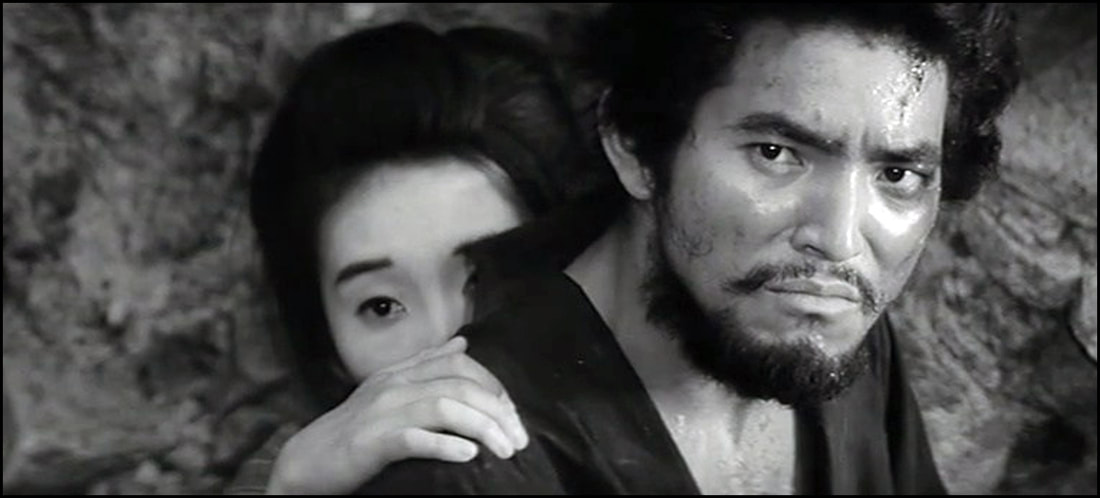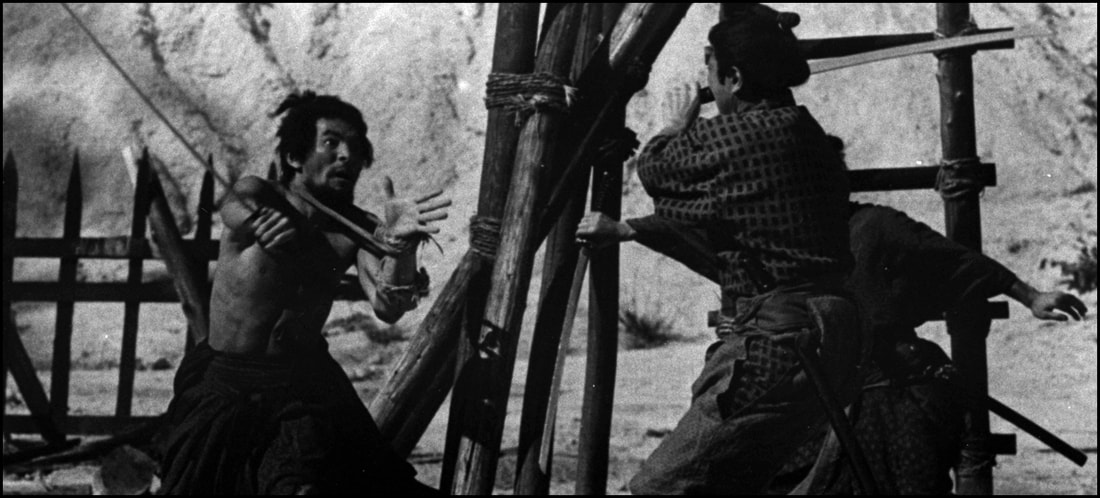As I’ve mentioned before, I grew up in a small town essentially in the middle of nowhere. Things like foreign films didn’t exist. There were no arthouse theaters in my one-horse town. Likewise, the small private college I attended really didn’t do much to change that aspect of my reality; while the Speech and Theater program did have some film classes, the bulk of that curriculum was centered around American-made classics, so I just had so little exposure to these films. Granted, I did start to find more titles in the late 1980’s and early 1990’s: a brief career in video retail swung open this door slowly, and I was glad to finally have access to an increasingly global library of content to inspire my film likes and dislikes.
So much has been written over the years suggesting how much the quintessential American Western owes to the Japanese samurai film and vice versa, so I don’t feel the need to explore that further. Suffice it to say, these two genres have so much in common that some might even find it difficult to tell them apart. The bottom line – so far as I’ve ever considered it – is that each has something to offer the other, and talented storytellers on both sides of the ocean have maximized crossover appeal to benefit of the audience.
Today’s treat – Hideo Gosha’s Samurai Wolf II: Hell Cut – is a picture I’ve long been aware of but unable to locate a suitable copy of for viewing and review purposes. So a hearty thanks goes out to Film Movement for continuing to bridge the cultural gap and deliver some of the lesser known productions to life again, especially on home video (as opposed to streaming). Don’t get me wrong: I’m all-in on streaming when I can, but – being as old school as I am – I still prefer physical media as it gives me greater opportunity to spend time with a gem like this.
And, yes, it is a gem, as is its predecessor.
(NOTE: The following review will contain minor spoilers necessary solely for the discussion of plot and/or characters. If you’re the type of reader who prefers a review entirely spoiler-free, then I’d encourage you to skip down to the last few paragraphs for the final assessment. If, however, you’re accepting of a few modest hints at ‘things to come,’ then read on …)
From the film’s IMDB.com page citation:
“Kiba is caught in the intrigue between a crooked goldmine owner, a cynical, betrayed swordsman, a manipulative lady and an arrogant dojo master.”
As I am not a professed master of the samurai film (as its own genre), I can say that I might occasionally struggle to make sense of a particular story.
It might be more appropriate to point out that I’m no expert on Japanese history, either, and I’ve seen several pictures wherein certain people, places, and events of that nation’s past figure in prominently (or prominently enough) that I lack a clear understanding of why something’s done, who the person of interest is, or what effect a development might have culturally. In some ways, this isn’t dissimilar from taking a great American comedy and showing it to, say, a Russian or an Indian or a Chinese person. Because of cultural differences, they may not ‘get the joke’ much less understand why something is funny. The bottom line is that I’ve accepted that sometimes stories just don’t translate the way they could (especially through subtitling and dubbing), and this might leave some to get a bit lost in the shuffle.
Still, Isao Natsuyagi elevates his acting game here as there’s much more for him to react to, and some of this even ties to giving his ronin a stronger background. We learn about his youth and his earlier days, mostly because he meets a criminal on the way to his trial named Magobei (played by Ko Nishimura) who resembles Kiba’s father, thus making this a more personal tale than the first picture. Nishimura definitely turns in some good marks as a swordsman who’s apparently been double-crossed by bandits he was recently partnered with, but as the picture wears on it grows increasingly difficult to understand what he’s truly wanting to accomplish here. Yes, he’s understandably bent on revenge, but yet he stops short once once or twice from dealing a true death blow to adversaries. In the end, I think his conflict needed a bit more obviousness and a bit less subtext.
Furthermore, Hell Cut delivers not one but two compelling female players to flesh out this wider conflict. Kiba rescues the young and pretty Oteru (Rumiko Fuji) from would-be assailers in the opening, only for the samurai to quickly learn she’s not quite of her right mind. She vacillates between being somewhat bereft to that of a frenzied state with little notice, and – before he can reach common ground – she vanishes into the hills. Later – on the road to town – Kiba meets Oren (Yuko Kusunoki), a dastardly and deceitful woman who’ll ‘hitch her wagon’ to any man who can be as dangerous as she is. Needless to say, these two females come into play throughout the entire running length of Hell Cut, and both either deliberately or accidentally spell trouble for our hero in ways even he couldn’t have imagined.
Thankfully, Gosha has pulled back on some of his stylistic tendencies displayed in the first film. The bulk of this project is a bit more routine, with the slow-motion and freeze frame trickery used sparingly by comparison. While it made for a better viewing experience for this reviewer, there were still small pieces of the story that just didn’t feel as organic. It’s still worth one’s time – at a lean 72 minutes – and has a helluva lot to offer. It just requires a bit more focus than I expected.
Samurai Wolf II: Hell Cut (1967) was produced by Toei Tokyo. DVD distribution (for this particular release) is being coordinated by the good people at Film Movement. As for the technical specifications? After a quick review of the Film Movement website, I’m not seeing any information regarding whether or not these were new scans of existing material, so I can’t comment on that. I can say that the film looks and sounds fabulous from start-to-finish, though some viewers might believe that there’s a loss of audio (on occasion) due to stylistic choices director Gosha employed. (FYI: there isn’t, and that sudden silence was part of his master plan.)
Lastly, if you’re looking for special features? The disc includes a video short exploring Gosha’s career (I believe the subject interviewed is actually Gosha’s daughter), and the collection includes a 20-page booklet exploring some of the same. While Samurai Wolf (1966) – also on the disc – comes with an audio commentary track, there’s sadly no additional materials concentrating on the sequel. (For my take on Samurai Wolf and its commentary, you can check out my review here.)
Highly recommended!
Samurai Wolf II: Hell Cut (1967) is a meatier flick than its predecessor, largely because its plot is a bit more complex and the script actually gives Kiba a modest origins story. (Don’t worry: it’s not all that distracting, and it has a very telling reason for doing so that incorporates into a Kiba/Magobei’s relationship.) Still, there were parts of it that I didn’t find all that interesting, and I couldn’t say why specifically. The performances are better in many ways, and the cast is generally fabulous with what they’ve provided. Still, I think its lack of a central villain held it back in some ways, and – as I was never quite able to get a handle on Magobei’s motivations – a few sequences failed to resonate. What can I say? Sometimes this happens with foreign releases.
In the interests of fairness, I’m pleased to disclose that the fine folks at Film Movement provided me with a complimentary Blu-ray of Samurai Wolf 1 & 2 by request for the expressed purposes of completing this review. Their contribution to me in no way, shape, or form influenced my opinion of it.
-- EZ



 RSS Feed
RSS Feed